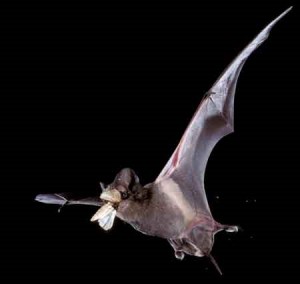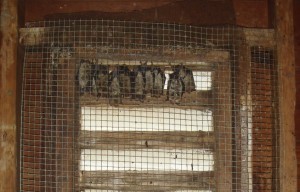Fall Can be a Batty Time for Schools
By Marcia Anderson
Just as children around the nation are back in school in the early fall, so are bats. Autumn is the time when many North American bats are beginning their trek south to overwinter in Mexico and Central America. Many schools are located along bat migration routes, so every fall, bats attempt to use them as rest stops.
Bats are essential to maintaining healthy ecosystems and economies. Some bats are primary pollinators of fruits and other produce. They spend their nights eating pests — mosquitoes, moths, as well as termites, ants and roaches in flight. A single Mexican freetail bat or little brown bat can eat 3,000 mosquito-sized insects per night. Their prey is easily found in open grasslands, parks, and school yards where insects are abundant. During the day, bats prefer to roost in tight crevices such as cracks in rocks, under exfoliating tree bark, and in awnings of buildings. Bats can enter buildings through openings as small as one-half inch in diameter.
One city’s high school experienced an annual bat problem. The building was over 100 years old, and every fall over 3,000 bats would spend time in the halls, classrooms, kitchen, and, primarily, the auditorium. The bats would fly in at dawn and exit at dusk at several sites scattered across the building. The custodians would go to work at 5 a.m., running nets through the school to capture the bats and release them outdoors. They would catch as many as they could before the start of the school day.
Then in 2005, the district began implementing an Integrated Pest Management (IPM) program. As the program got underway, the facilities management team soon began to understand how the bats were entering the building. As with preventing other pests that enter schools, exclusion was part of the IPM process that needed to be implemented. An 80-foot lift allowed staff to get high enough to seal the openings where the bats were entering.
Over the next three years, there was a significant decrease in the number of bats entering the school. By 2010, only one or two bats would find their way into the building when someone on the 3rd or 4th floor would accidently leave a window open. The good news for the bats was that the district had the foresight to place bat houses on the roof of the school so the bats would have a place to rest, undisturbed, on their long journey south.
A related problem the school had to deal with was the bat guano deposited in the attic spaces above classrooms. There are health hazards associated with bat guano, such as Histoplasma capsulatum, a fungus which, if inhaled, can develop into a serious respiratory disease. Guano also needs to be removed from interior structures to avoid attracting other pests such as cockroaches and flies. A professional hazardous waste cleanup company was hired to remove the bat guano.
In another part of the country, a school had hundreds of bats spend an entire season adjacent to their gymnasium. The bats found a perfect roosting space between the gutter and the building that ran for 500 linear feet. The void was about four inches high and ¾ inches wide, in a very high location, and inaccessible to predators – a perfect spot for bats. The local health department shut down the gym. The guano that collected on the ground below the bats had to be swept up daily. Some, however, fell inside the gym wall void. The facilities staff applied an enzyme inside of the wall void to neutralize any pathogens in the guano. To solve the problem, the school removed the gutter, installed flashing, and then reinstalled the gutter. This bat incident cost the district over $250,000.
Yet another school had an overhang 30 feet off of the ground that the bats loved. To keep them from roosting, the facilities staff filled the voids, added metal panels, and sealed the seams.
Got bats in your school? Don’t panic. They’re rarely aggressive. Do warn students not to pet, catch, comfort, kick, or shoo them away, as some bats carry rabies. Teach them to stay back and notify a teacher or staff member.
Exclusion is an essential step in IPM. Close all potential bat entry points using sealant, weather stripping, flashing, or heavy-duty ¼-inch hardware cloth. Identify bat entry points by inspecting along roof lines and under gutters for rub marks – stains left by the oils and dirt rubbing off the bats’ hair. Also look on the ground for guano.
Before taking action, know the bat species involved. A few bats are federally protected, so it is important to comply with the law. There may be more than one bat species sharing a roost. Identification can also help if the district is considering building alternative housing for the bats. Each bat house should be appropriate for the species, large enough to hold several hundred bats, and placed away from students. Not all commercially available bat houses are suitable for North American bats. Bat Conservation International provides information on how to build, buy, and install a bat house. There are also free plans for bat houses available online. Install new bat houses a few weeks prior to the actual bat exclusion, to allow them time to find the new shelter.
Lastly, Texas A&M University provides good information on bat control in schools.








